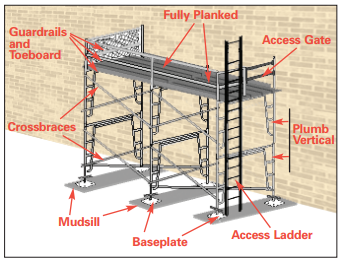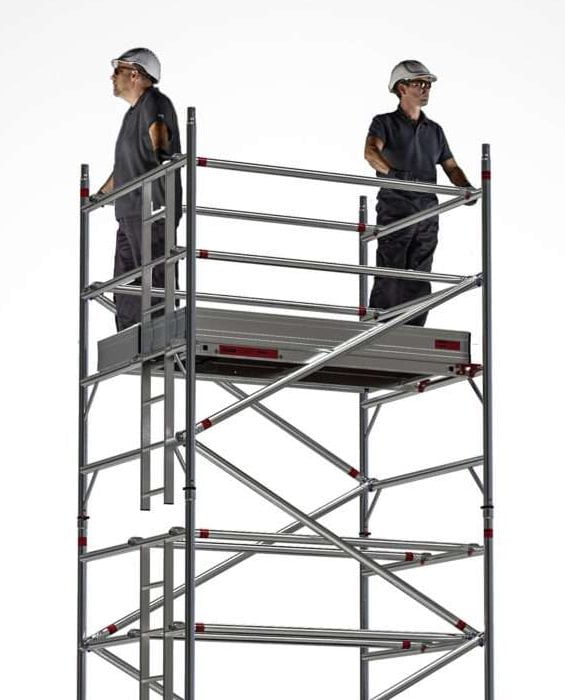Temporary Roof Scaffolding to Ensure Safe Working Conditions During Projects
Temporary Roof Scaffolding to Ensure Safe Working Conditions During Projects
Blog Article
A Comprehensive Overview to the Essential Attributes of Scaffolding in Modern Construction
The landscape of contemporary building progressively depends on efficient scaffolding systems that prioritize safety, advancement, and performance. As jobs grow in intricacy, understanding the necessary attributes of scaffolding comes to be vital for making sure employee security and optimizing task timelines.
Kinds Of Scaffolding
Although scaffolding systems can vary widely in layout and application, they normally drop right into numerous distinctive groups that provide to different construction needs - Scaffolding. One of the most typical kinds consist of sustained scaffolding, put on hold scaffolding, and rolling scaffolding
Sustained scaffolding contains platforms supported by a framework of poles, which supply a stable and elevated functioning surface. This kind is normally made use of for jobs that need considerable altitude, such as bricklaying or external paint.
Suspended scaffolding, conversely, is made use of for tasks calling for access to high elevations, such as cleansing or repairing building facades. This system hangs from another structure or a roof, allowing employees to reduced or increase the platform as required.
Moving scaffolding attributes wheels that enable for simple movement across a task site. It is especially useful for tasks that require constant moving, such as interior operate in large rooms.
Each kind of scaffolding is made with details applications in mind, making certain that construction tasks can be accomplished successfully and efficiently. Understanding these groups is vital for picking the appropriate scaffolding system to satisfy both project needs and website problems.
Secret Safety And Security Attributes
Safety and security is extremely important in scaffolding systems, as the potential threats associated with working at heights can result in significant accidents otherwise correctly managed. Key security features are vital to ensure the wellness of employees and the honesty of the building site.
Firstly, guardrails are vital. These barriers supply a physical protect versus falls, substantially reducing the threat of severe injuries. Furthermore, toe boards are usually made use of to stop tools and products from falling off the scaffold, protecting workers below.
Another crucial element is the use of non-slip surfaces on platforms. This feature boosts grasp, especially in adverse weather conditions, thus lessening the possibility of drops and slips. Accessibility ladders must be firmly positioned to assist in secure access and departure from the scaffold.
Regular examinations and maintenance of scaffolding systems are additionally essential. These examinations make certain that all parts are in great condition and operating appropriately, addressing any kind of wear or damage promptly.
Last but not least, appropriate training for all personnel associated with scaffolding operations is vital to make sure that they comprehend security protocols and can determine possible dangers. Scaffolding. Jointly, these functions create a more secure working environment and dramatically minimize risks related to scaffolding
Product Technologies
Improvements in material scientific research have dramatically influenced the scaffolding sector, boosting both security and efficiency in contemporary construction. The introduction of high-strength steel and aluminum alloys has revolutionized typical scaffolding systems. These materials are not only lighter, making them much easier to assemble and carry, however additionally provide exceptional load-bearing capacities. This causes scaffolding structures that can support greater weights while decreasing the danger of collapse.
Furthermore, innovative composite materials, such as fiberglass-reinforced plastics, have actually become sensible choices. These materials are resistant to corrosion and ecological deterioration, thus extending the lifespan of scaffolding systems, specifically in extreme climate condition. Making use of such products contributes to reduce maintenance prices and ensures constant performance over time.


Style Factors To Consider
Taking into consideration the complexities of contemporary construction jobs, efficient scaffolding design is paramount to making certain both functionality and security. Layout click site considerations need to incorporate numerous elements, including load capacity, height, and the particular demands of the building and construction site. Each project offers distinct challenges, demanding an adaptable approach to scaffolding systems that can adjust to varying problems.
Architectural integrity is crucial; as a result, designers should compute the lots that the scaffolding will certainly sustain, consisting of employees, products, and tools. The option of materials plays a vital duty in guaranteeing the scaffolding can endure these loads while staying light-weight and resilient. In addition, the style has to enable simple accessibility and egress, assisting in the smooth motion of materials and employees.
Safety features, such as guardrails and non-slip surface areas, should be included to lessen dangers of accidents. The layout has to take into consideration the surrounding setting, consisting of adjacent frameworks and potential dangers. By addressing these style factors to consider, building firms can enhance the effectiveness of scaffolding systems and promote a safer working setting, inevitably adding to the overall success of the job.
Upkeep and Inspections
The effectiveness of scaffolding systems extends beyond first layout and execution; recurring maintenance and routine assessments are important to guaranteeing their continued performance and safety throughout the duration of a project. Normal inspections must be conducted by certified personnel to determine any indications of wear, damages, or instability that could compromise the honesty of the scaffolding.
Maintenance protocols should include routine checks of architectural components, such as slabs, installations, and frameworks, guaranteeing that all elements stay totally free and protected from corrosion or other degeneration. Furthermore, the performance of safety and security functions, such as guardrails and toe boards, must redirected here be evaluated to ensure conformity with security regulations.
Documentation of all assessments and maintenance tasks is critical for responsibility and regulative conformity. A systematic technique to record-keeping not only aids in tracking the problem of the scaffolding however also provides essential proof in the event of an incident.
Inevitably, developing a detailed upkeep and assessment schedule will significantly lower the threat of crashes and improve the total safety and security of the building and construction straight from the source site. By focusing on these techniques, building and construction supervisors can guard employees and support the project's honesty.

Conclusion
To conclude, the important features of scaffolding in modern-day building and construction include a variety of essential elements, consisting of diverse kinds, crucial security devices, material technologies, and thoughtful design factors to consider. Emphasizing security through guardrails and non-slip surfaces, together with developments in products like high-strength steel, improves both efficiency and sustainability. Routine upkeep and inspections are essential for making certain structural stability and security on building and construction websites, ultimately facilitating efficient task implementation and advertising the well-being of workers.
The landscape of modern construction progressively counts on efficient scaffolding systems that prioritize safety and security, technology, and performance.Advancements in product science have actually considerably affected the scaffolding sector, boosting both safety and security and effectiveness in modern-day building. Overall, these material advancements not only boost the performance and security of scaffolding systems however also line up with the sector's press towards sustainability, as many modern materials are made to be much more eco pleasant.
Taking into consideration the complexities of contemporary building and construction jobs, effective scaffolding design is critical to making certain both functionality and security.In final thought, the necessary functions of scaffolding in contemporary building include a variety of crucial elements, consisting of diverse types, crucial security devices, material advancements, and thoughtful design factors to consider.
Report this page